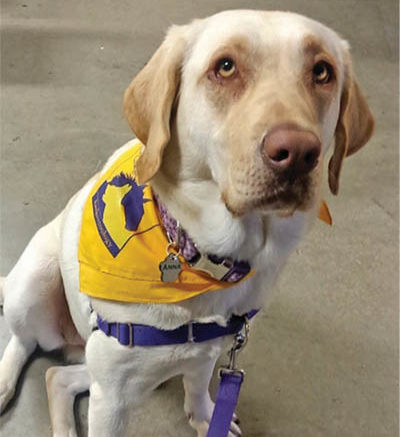By Stacy Walenter
Troy High School counselor Kelly Palmer enjoys going to work but, he admits, he needs a couple of cups of coffee before he can truly appreciate the morning.
Anna, on the other hand, wakes up excited for the moment that she can jump in the truck and head to school. No coffee needed.
Once she gets to school, her first order of business is to leave Palmer at the school’s back door and sprint to math and science teacher Mr. Bara’s room. Mr. Bara keeps no less than two varieties of dog treats for his daily morning visitor.
After her treat and visit, Palmer and Anna head to Palmer’s office next door. As children begin arriving at school, the duo stands in the hallway to greet kids as they head to class.
Anna is Troy High School’s resident therapy dog. Therapy animals come in three tiers, Palmer explained during an interview on March 1. Tier one animals are American Disabilities Act (A.D.A.)-approved animals, such as seeing-eye dogs, which are allowed into restaurants, stores, and onto planes. Tier two animals, known as therapy animals or facility animals, receive extensive training but are not covered by the A.D.A.
Tier three animals, known as emotional support animals, have often been in the news because of recent abuses. This lowest tier of support animals have no rights under A.D.A. laws, but people have tried to use the tier one rules. For instance, in January, a woman tried to take her emotional support peacock on a United Airlines flight.
Anna is a tier two therapy dog. She was trained at Carroll College by students in the anthrozoology program. According to the college’s website, anthrozoology is about “helping people live better lives [through] animal-assisted therapy techniques and programs designed to help people of all ages overcome a vast array of physical and mental hardships.”
Carroll College acquires the dogs they train from shelters around the state.
Anna trained for two semesters with her handler, Breanna, who served as Anna’s foster mom. Breanna trained Anna in behaviors such as interrupting self-harm and calmly enduring rough handling.
Because of privacy laws, individual examples of how Anna has improved students’ lives cannot be fully expressed. Generally, however, Palmer said, Anna improves the mood of the school.
When she gets the urge to run up and down the hallways, it’s hard not to laugh.
“When kids are going through a rough patch,” Palmer said, “Anna gives the sort of unconditional love that only animals and small children seem able to provide.”
Anna is not susceptible to the fragmentation of the high school social scene.
“Anna doesn’t care if you’re cool, if you’re a jock, if you get straight A’s. She loves everyone. She’s a great equalizer,” Palmer said.
In Palmer’s office, Anna has an innate understanding of when kids are emotionally distraught. When they’re upset, she lays her head in their laps. Palmer sometimes plays second fiddle to Anna because kids will come to his office to pet her without saying much to him.
On average, she receives at least 20 belly rubs per day from the students she serves.
Jacob Francom, Troy Schools superintendent and high school principal, originally had the idea to introduce a therapy dog over two years ago. Nationwide there had been a movement to bring therapy animals into the school environment.
Francom had been in contact with a school in Lolo, as well as the principal in east Helena. East Helena had success with one of Carroll College’s therapy dogs. Francom approached Palmer about the idea, as a therapy animal would be a logical extension of the work Palmer already did. However, Palmer was not immediately receptive to the idea.
Palmer had recently and unexpectedly lost his beloved black labrador, Koda. Palmer had given Koda to his daughter as a birthday present eight-and-a-half years prior. Koda was then given to to Palmer’s son. After his son went to college, the dog was Palmer’s constant companion. Koda’s death weighed heavily on him and he initially turned down Francom’s suggestion.
Over a year and a half later, time had healed some of the pain and Palmer was open to exploring the idea of a therapy dog. The school wrote parents to make sure children weren’t allergic to dog dander and to see whether any kids had negative experiences with dogs. With the all clear, the process began.
The timing was serendipitous for meeting Anna.
Palmer visited Carroll College in December 2016 and, based on his research, was drawn to Anna, a low-energy, yellow labrador. The two got along and Anna responded well to Palmer’s commands. There were about 20 applications for Anna, but she was ultimately awarded to Palmer.
Carroll College did not charge for Anna’s training, so Palmer had to pay only the adoption fee from the shelter in Dillon where Anna was found. Though Anna works for Troy High School, Anna is Palmer’s dog; he pays for her food, her upkeep, and any necessary veterinarian bills.
The school, however, did contribute a large roll of plastic bags to Palmer, for those times when Anna leaves behind something other than happiness.
Superintendent Fracom sees a noticeable difference in students. He said they open up when Anna enters the room and have expressed how happy they are to have a dog at school.
“Research shows that people should have at least seven positive interactions in one day,” Francom said. “Anna helps give those positive interactions.”
“She’s not a miracle worker,” Palmer said. “It’s not like suddenly all of our kids are going to go to Ivy League schools because of a therapy dog; it’s just joy and the human/animal bond. That’s what we’re trying to bring to the school. Anna is just another way to make school a happier place.”
Those interested in learning more about Anna’s training and seeing updates can visit her Facebook page at: http://www.facebook. com/annasadventuresmt.

